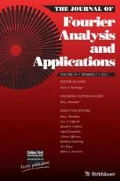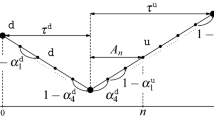Abstract
Using tools from the theory of stationary random distributions developed in Itô (Mem. Coll. Sci., Univ. Kyoto, Ser. A: Math., 28:209–223, 1954) and Yaglom (Theory Probab. Appl., 2:273–320, 1957), we introduce a new class of processes which can be used as a model for the noise perturbing an SPDE. This type of noise is not necessarily Gaussian, but it includes the spatially homogeneous Gaussian noise introduced in Dalang (Electron. J. Probab. 4(6) 1999), and the fractional noise considered in Balan and Tudor (Stoch. Process. Appl., 120:2468–2494, 2010). We derive some general conditions for the existence of a random field solution of a linear SPDE with this type of noise, under some mild conditions imposed on the Green function of the differential operator which appears in this equation. This methodology is applied to the study of the heat and wave equations (possibly replacing the Laplacian by one of its fractional powers), extending in this manner the results of Balan and Tudor (Stoch. Process. Appl., 120:2468–2494, 2010) to the case H<1/2.
Similar content being viewed by others
References
Balan, R.M.: Some linear SPDEs driven by a fractional noise with Hurst index greater than 1/2 (2011). Preprint. Available on arXiv:1102.3992
Balan, R.M., Tudor, C.A.: The stochastic heat equation with fractional-colored noise: existence of the solution. ALEA Lat. Am. J. Probab. Math. Stat. 4, 57–87 (2008)
Balan, R.M., Tudor, C.A.: The stochastic wave equation with fractional noise: a random field approach. Stoch. Process. Appl. 120, 2468–2494 (2010)
Bardina, X., Florit, C.: Approximation in law to the d-parameter FBS based on the functional invariance principle. Rev. Mat. Iberoam. 21, 1037–1052 (2005)
Billingsley, P.: Probability and Measure, 3rd edn. Wiley, New York (1995)
Bochner, S.: Stationarity, boundedness, almost periodicity of random-valued functions. In: Proc. Third Berkeley Symp. Math. Stat. Probab., vol. 2, pp. 7–27. University of California Press, Berkeley (1956)
Bonami, A., Estrade, A.: Anisotropic analysis of some Gaussian models. J. Fourier Anal. Appl. 9, 215–236 (2003)
Clausel, M., Vesel, B.: Explicit construction of operator scaling Gaussian random fields. Fractals 19, 101–111 (2011)
Dalang, R.C.: Extending martingale measure stochastic integral with applications to spatially homogenous S.P.D.E.’s. Electron. J. Probab. 4, paper no. 6 (electronic) (1999). 29 pp.
Dalang, R.C., Frangos, N.E.: The stochastic wave equation in two spatial dimensions. Ann. Probab. 26, 187–212 (1998)
Dalang, R.C., Mueller, C.: Some non-linear S.P.D.E.’s that are second order in time. Electron. J. Probab. 8(1), 1–21 (2003)
Dalang, R.C., Sanz-Solé, M.: Regularity of the sample paths of a class of second order S.P.D.E.’s. J. Funct. Anal. 227, 304–337 (2005)
Dobrushin, R.L., Major, P.: Non-central limit theorems for non-linear functionals of Gaussian fields. Z. Wahrscheinlichkeitstheor. Verw. Geb. 50, 27–52 (1979)
Doob, J.L.: Stochastic Processes. Wiley, New York (1953)
Foondun, M., Khoshnevisan, D.: On the stochastic heat equation with spatially-colored random forcing. Trans. Am. Math. Soc. (2012, to appear). Preprint. Available on. arXiv:1003.0348
Gel’fand, I.M., Vilenkin, N.Y.: Generalized Functions, vol. 4. Applications of Harmonic Analysis. Academic Press, New York (1964). Translated from the Russian by Amiel Feinstein
Hu, Y.: Heat equations with fractional white noise potentials. Appl. Math. Optim. 43, 221–243 (2001)
Hu, Y., Nualart, D., Song, J.: Feynman-Kac formula for heat equation driven by fractional white noise. Ann. Probab. 39, 291–326 (2011)
Itô, K.: Stationary random distributions. Mem. Coll. Sci., Univ. Kyoto, Ser. A: Math. 28, 209–223 (1954)
Jolis, M.: On the Wiener integral with respect to the fractional Bronwian motion on an interval. J. Math. Anal. Appl. 330, 1115–1127 (2007)
Jolis, M.: The wiener integral with respect to second order processes with stationary increments. J. Math. Anal. Appl. 366, 607–620 (2010)
Kamont, A.: On the fractional anisotropic Wiener field. Probab. Math. Stat. 18, 85–98 (1996)
Khoshnevisan, D.: Multiparameter Processes. An Introduction to Random Fields. Springer, New York (2002)
Khoshnevisan, D., Xiao, Y.: Harmonic analysis of additive Lévy processes. Probab. Theory Relat. Fields 145, 459–515 (2009)
Léger, S., Pontier, M.: Drap Brownien fractionnaire. C.R.A.S. Paris, Ser. I 329, 893–898 (1999)
Li, Y., Xiao, Y.: Multivariate operator-self-similar random fields. Stoch. Process. Appl. 121, 1178–1200 (2011)
Lindstrom, M.: Fractional Brownian fields as integrals of white noise. Bull. Lond. Math. Soc. 25, 83–88 (1993)
Loève, M.: Probability Theory. Van Nostrand, Princeton (1954)
Marquez-Carreras, D.: Generalized stochastic heat equations. In: Malliavin Calculus and Stochastic Analysis: a Festschrift in Honor of David Nualart. Proceedings in Mathematics. Springer, Berlin (2012, to appear)
Mura, A., Mainardi, F.: A class of self-similar stochastic processes with stationary increments to model anomalous diffusion in physics. In: Proceedings of the Conference “Linear and Non-linear Theory of Generalized Functions and Its Applications”, Bedlewo, Poland, 2007. Integr. Transforms Special Funct., vol. 20 (2009)
Pipiras, V., Taqqu, M.S.: Integration questions related to fractional Brownian motion. Probab. Theory Relat. Fields 118, 251–291 (2000)
Pipiras, V., Taqqu, M.: Are classes of deterministic integrands for the fractional Brownian motion on a finite interval complete? Bernoulli 7, 873–897 (2001)
Rao, M.M.: Representation of weakly harmonizable processes. Proc. Natl. Acad. Sci. USA 78, 5288–5289 (1981)
Stein, E.M.: Singular Integrals and Differentiability Properties of Functions. Princeton University Press, Princeton (1970)
Yaglom, A.M.: Some classes of random fields in n-dimensional space, related to stationary random processes. Theory Probab. Appl. 2, 273–320 (1957)
Yaglom, A.M.: Correlation Theory of Stationary and Related Random Functions. Springer, Berlin (1987)
Acknowledgements
The author would like to thank Davar Khoshnevisan for drawing her attention to the class of processes with stationary increments as a possible replacement for the fBm (which appears in the temporal component of the Gaussian noise of [1]), and also for pointing out a simplified proof of Lemma B.1(i).
Author information
Authors and Affiliations
Corresponding author
Additional information
Communicated by Christian Houdré.
Research supported by a grant from the Natural Sciences and Engineering Research Council of Canada.
Appendices
Appendix A: The Stochastic Integral with Respect to \(\mathcal{M}\)
Let \(\mathcal{M}=\{\mathcal{M}(A);A \in\mathcal{R}_{d}\}\) be a complex random measure indexed by rectangles, with control measure μ, as specified by Definition 2.2.
Let \(\varphi\in L_{\mathbb{C}}^{2}(\mathbb{R}^{d},\mu)\) be a continuous function. We give below the construction of the stochastic integral of φ with respect to \(\mathcal{M}\).
Step 1. Let \(A \in\mathcal{R}_{d}\) be fixed. The stochastic integral of φ over A, with respect to \(\mathcal{M}\) is defined as the \(L_{\mathbb{C} }^{2}(\varOmega)\)-limit of \(X_{n}=\sum_{j=1}^{k_{n}}\varphi(\tau _{j,n})\mathcal{M} (A_{j,n})\), n≥1, where \(\Delta_{n}=(A_{j,n})_{1 \leq j \leq k_{n}}\) is a partition of A into sets from \(\mathcal{R}_{d}\) such that \(\| \Delta_{n}\| =\max_{j \leq k_{n}}|A_{j,n}| \to0\), and τ j,n ∈A j,n is arbitrary. The limit exists, since the sequence (X n ) n≥1 is Cauchy: using the orthogonality and additivity of \(\mathcal{M}\), one can prove that E|X n −X m |2=∫ A |φ n −φ m |2 dμ, where \(\varphi_{n}=\sum_{j=1}^{k_{n}}\varphi(\tau_{j,n})1_{A_{j,n}}\) and ∫ A |φ n |2 dμ→∫ A |φ|2 dμ, by the definition of the Stieltjes integral (see e.g. p. 228 of [5]). In this calculation, we used the fact that
which is again a consequence of the orthogonality and additivity of \(\mathcal{M}\). One can show that the limit of (X n ) n does not depend on the choice of (Δ n ) n and (τ j,n ) j,n . This limit is denoted by \(\mathcal{M}_{A}(\varphi)=\int_{A}\varphi(\tau)\mathcal{M}(d\tau)\).
This stochastic integral has the following properties:
-
(a)
\(\mathcal{M}_{A}(\varphi+\psi)=\mathcal{M}_{A}(\varphi )+\mathcal{M}_{A}(\psi)\) a.s.;
-
(b)
\(E[\mathcal{M}_{A}(\varphi)]=0\) and \(E[\mathcal {M}_{A}(\varphi)\overline {\mathcal{M}_{A}(\psi )}]=\int_{A}\varphi\overline{\psi} d\mu\).
If in addition \(\mathcal{M}\) is symmetric, then the following property also holds:
-
(c)
\(\mathcal{M}_{A}^{-}(\varphi)=\overline{\mathcal{M}}_{A}(\varphi )\), where \(\mathcal{M}_{A}^{-}(B)=\mathcal{M}_{A}(-B)\) and \(\overline{\mathcal{M}}_{A}(B)=\overline{\mathcal{M}_{A}(B)}\).
Step 2. The stochastic integral of φ with respect to \(\mathcal{M} \) is defined as the \(L_{\mathbb{C}}^{2}(\varOmega)\)-limit of \(Y_{n}=\mathcal{M} _{A_{n}}(\varphi )\), n≥1, where the sequence \((A_{n})_{n} \subset\mathcal{R}_{d}\) is chosen such that A n ⊂A n+1 for all n, and ⋃ n A n =ℝd. The sequence (Y n ) n is Cauchy, since \(E|Y_{n}-Y_{m}|^{2}=\int_{A_{m} \backslash A_{n}}|\varphi|^{2} d\mu\) for any m>n, and \(\int _{A_{n}}|\varphi|^{2} d\mu\to\int_{\mathbb{R}^{d}}|\varphi|^{2} d\mu\) by the monotone convergence theorem. Since the limit of (Y n ) n does not depend on the choice of (A n ) n , we denote it by \(\mathcal{M}(\varphi)=\int_{\mathbb {R}^{d}}\varphi(\tau )\mathcal{M} (d\tau)\). This stochastic integral enjoys properties similar to (a)–(c) above. In particular,
Moreover, if \(\mathcal{M}\) is symmetric, then \(\mathcal{M}(\varphi)\) is a real-valued random variable for any function φ such that \(\overline {\varphi (\tau)}=\varphi(-\tau)\) for all τ∈ℝd. This follows since
where we used from property (c) for the second equality above.
Appendix B: Some Elementary Estimates
Lemma B.1
Let γ∈(−1,1) be arbitrary. (i) For any a>0, we have:
where C γ =∫ℝ(s 2+1)−1 s −γ ds. (ii) For any a>1, we have:
where \(C_{\gamma}^{(1)}\) and \(C_{\gamma}^{(2)}\) are some positive constants depending on γ.
Proof
(i) The conclusion follows by the change of variable τ/a=τ′.
(ii) We denote by I 1 and I 2 the integrals over the regions |τ|≤a, respectively |τ|≥a. We use the notation f(τ)∼g(τ) if c 1 g(τ)≤f(τ)≤c 2 g(τ) for any τ∈ℝ, for some constants c 1,c 2>0. When |τ|≤a,
and hence I 1 is bounded below and above by some constants multiplied by:
When |τ|≥a,
and hence I 2 is bounded below and above by some constants multiplied by:
□
Lemma B.2
Suppose that η satisfies either (C1) or (C2). Then for any K>0 there exists a constant M K >0 such that
Proof
If (C1) holds, then

If (C2) holds, then

□
Appendix C: Verification of Conditions (Hyperbolic Case)
Lemma C.1
(i) Let η(τ)=|τ|−γ with γ∈(−1,1). Then η satisfies (C). If γ∈(0,1), then η satisfies (C1). If γ∈(−1,0), then η satisfies (C2).
(ii) Let η(τ)=(1+τ 2)−γ/2 with γ>−1. Then η satisfies (C). If γ∈(0,1), then η satisfies (C1). If γ∈(−1,0), then η satisfies (C2).
Proof
(i)(C) is clearly satisfied since η(λτ)/η(τ)=λ −γ=:C λ for any τ>0.
If γ∈(0,1), (C1) holds since for any a>0,
If γ∈(−1,0), (C2) holds since for any a>0,
(ii) We first check (C). If γ>0, then the inequality
is equivalent to \(1+\lambda^{2} \tau^{2} \geq C_{\lambda}^{-2/\gamma}(1+\tau^{2})\). We choose C λ ={min(1,λ 2)}−γ/2.
If γ<0, then (57) is equivalent to \(1+\lambda^{2} \tau^{2} \leq C_{\lambda}^{-2/\gamma}(1+\tau^{2})\). We choose C λ ={max(1,λ 2)}−γ/2. If γ∈(0,1) then (C1) holds since for any a≥K,
where C K =1+K −2. If γ∈(−1,0) then (C2) holds since for any a≥K,

□
Rights and permissions
About this article
Cite this article
Balan, R.M. Linear SPDEs Driven by Stationary Random Distributions. J Fourier Anal Appl 18, 1113–1145 (2012). https://doi.org/10.1007/s00041-012-9240-7
Received:
Revised:
Published:
Issue Date:
DOI: https://doi.org/10.1007/s00041-012-9240-7
Keywords
- Stationary random distributions
- Stochastic partial differential equations
- Stochastic integral
- Processes with stationary increments
- Fractional Brownian motion



